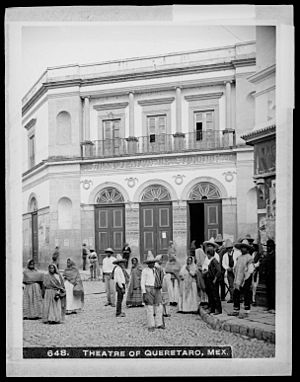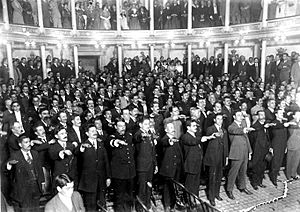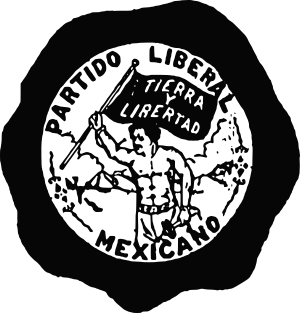Constitution of Mexico facts for kids
Quick facts for kids Political Constitution of the United Mexican States |
|
|---|---|
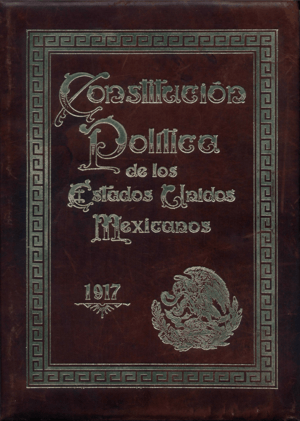
Cover of the original copy of the Constitution
|
|
| Jurisdiction | Mexico |
| Ratified | 5 February 1917 |
| System | Constitutional presidential republic |
| Branches | 3 |
| Chambers | Bicameral (Senate and Chamber of Deputies) |
| Executive | President |
| Electoral college | Yes, the Chamber of Deputies elects an acting president when necessary; Deputies validated presidential elections until 1993. |
| First legislature | 15 April 1917 |
| First executive | 1 May 1917 |
| Location | Lecumberri Palace |
| Author(s) | Constituent Congress of 1917 |
| Supersedes | Constitution of 1857 |
The Constitution of Mexico is the main rulebook for the country. Its full name is the Political Constitution of the United Mexican States (in Spanish, Constitución Política de los Estados Unidos Mexicanos). It was created in Santiago de Querétaro, during the Mexican Revolution. A special group called the Constituent Congress approved it on February 5, 1917.
This Constitution replaced an older one from 1857. It was a huge step forward for Mexico. Many people see it as the legal success of the Mexican Revolution.
The 1917 Constitution was the first in the world to include social rights. This means it protected rights for everyday people, not just political ones. It inspired other countries, like Germany (Weimar Constitution of 1919) and Russia (1918).
Some of its most important parts are Articles 3, 27, and 123. These articles brought big changes to Mexico after the Revolution. They helped shape the country's politics and society for many years. Article 3 made education free, required, and non-religious. Article 27 set up rules for land reform in Mexico, giving land to farmers. Article 123 gave more power to workers and protected their rights.
For a long time, some articles (like 3, 5, 24, 27, and 130) limited the power of the Roman Catholic Church. When President Plutarco Calles tried to strictly enforce these rules in 1926, it led to a conflict called the Cristero War.
In 1992, under President Carlos Salinas de Gortari, some parts of the Constitution were changed. Article 27 was updated to make private property rights stronger and allow ejidos (community lands) to be privatized. Also, many rules limiting the Catholic Church were removed.
Constitution Day (Día de la Constitución) is a national holiday in Mexico. It celebrates the day the Constitution was approved, February 5, 1917. Even though the official date is February 5, the holiday is always celebrated on the first Monday of February.
Contents
- What are the Main Ideas of the Mexican Constitution?
- How the Constitution is Organized
- The Story Behind the Constitution
- Important Articles of the Constitution Today
- Article 1
- Article 2
- Article 3
- Article 4
- Article 5
- Article 6
- Article 7
- Article 8
- Article 9
- Article 10
- Article 11
- Article 12
- Article 13
- Article 14
- Article 15
- Article 16
- Article 17
- Article 18
- Article 20
- Article 21
- Article 23
- Article 24
- Article 25
- Article 26
- Article 27
- Article 28
- Article 29
- Article 30
- Article 31
- Article 32
- Article 33
- Article 39
- Article 34
- Article 55
- Article 91
- Article 95
- Article 123
- Article 130
- See also
What are the Main Ideas of the Mexican Constitution?
The Constitution is built on seven key principles:
- Human Rights: It lists the rights of all people.
- National Power: The nation itself holds the highest power.
- Separate Powers: Government power is split into different branches (like legislative, executive, judicial).
- Representative Government: People choose their leaders to represent them.
- Federal System: Power is shared between the national government and the states.
- Legal Protection: There are ways to challenge laws if they violate rights.
- State Over Church: The government is separate from and has authority over religious institutions.
How the Constitution is Organized
The Constitution is divided into sections called "Titles" (Títulos). Each Title covers a main topic and contains several articles.
First Title:
- Chapter I: About Human Rights and their Protections
- Chapter II: About Mexicans
- Chapter III: About Foreigners
- Chapter IV: About Mexican Citizens
Second Title:
- Chapter I: About National Power and Government Type
- Chapter II: About the Parts of the Federation and the National Territory
Third Title:
- Chapter I: About the Separation of Powers
- Chapter II: About the Legislative Branch (Congress)
- Chapter III: About the Executive Branch (President)
- Chapter IV: About the Judicial Branch (Courts)
Fourth Title:
- About the responsibilities of public officials and state property.
Fifth Title:
- About the States of the Federation and the Federal District (Mexico City).
Sixth Title:
- About Work and Social Welfare (worker protections).
Seventh Title:
- General Rules.
Eighth Title:
- About Changes to the Constitution.
Ninth Title:
- About the Constitution's Inviolability (how it cannot be easily broken).
The Story Behind the Constitution
Why a New Constitution?
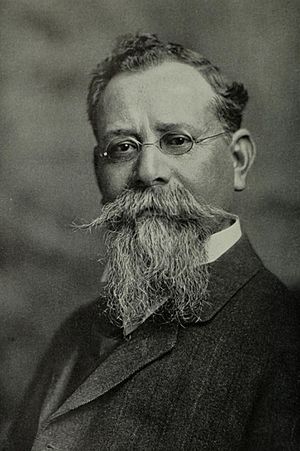
The 1917 Constitution was a major result of the Mexican Revolution, which began in 1910. The winning side, led by Venustiano Carranza, used the older 1857 Constitution to unite people against General Victoriano Huerta. Huerta had taken power in 1913.
However, the revolutionaries were fighting for more than just political changes. They wanted social and economic reforms too. Carranza's group won in 1915.
At first, Carranza only wanted to make small changes to the 1857 Constitution. But his advisors convinced him that a completely new constitution was better. This new document would include all the big changes the revolutionaries fought for. It would also give the new government more power and legitimacy.
The Constitutional Convention
Carranza called for a special congress to write the new constitution. This meeting happened in Querétaro, not the capital city. Querétaro was chosen because it was a peaceful place for such an important meeting. The congress started in November 1916 and finished the final draft by February 5, 1917.
Unlike earlier constitutions that took many years, this one was written very quickly. Some historians believe Carranza wanted a constitution fast, even if it wasn't perfect. This was partly because General Pancho Villa's forces were still a threat.
Who Were the Delegates?
The people who wrote the Constitution were called delegates. They were elected, but only those who supported Carranza's side could participate. This meant that groups like Villistas and Zapatistas were not included.
Most delegates were middle-class professionals, like lawyers, teachers, and doctors. A few were revolutionary generals. Even though they were all from Carranza's side, they had different ideas. The demands of the excluded groups, like peasants and workers, still pushed the delegates to include social rights.
Carranza's First Draft
Carranza himself presented a draft of the constitution in December 1916. But his draft mostly just reorganized the old 1857 Constitution. It didn't include many of the big changes people wanted. The delegates did not accept it. They wanted something much more revolutionary.
Big Debates
The delegates had strong disagreements over articles about education and the Catholic Church. However, the articles about the government's power over land (Article 27) and workers' rights (Article 123) passed easily. These two articles were seen as very revolutionary.
Rules for the Church
Article 3, about education, caused a lot of debate. Carranza's draft said education would be secular (non-religious). But other delegates wanted even stronger rules. They wanted to make sure no religious groups could run primary schools.
The Constitution of 1857 already limited the Catholic Church. The 1917 Constitution went even further. Many delegates saw the Church as an obstacle to a modern, independent Mexico. They believed the Church had too much power, especially through education. The new rules aimed to build a strong, secular nation.
Land and Natural Resources
Article 27 gave the government power over natural resources, like oil, and allowed it to redistribute land. This was a huge change for peasants who had fought for land rights. It also said that foreigners could not own land near Mexico's borders or coasts. This was a response to past foreign interventions.
Workers' Rights
A big win for workers was including their rights in Article 123. Workers had played a key role in the Revolution. This article gave them protections like an eight-hour workday, the right to strike, a weekly day of rest, and fair pay if they lost their jobs. It also said that men and women should be treated equally in the workplace.
Women's Right to Vote
The congress discussed whether women should be allowed to vote. There were women's rights groups, but they were not as strong in Mexico as in some other countries. A supporter of Carranza, Hermila Galindo, asked the convention to let women vote.
However, the committee decided not to give women the right to vote. They believed women did not feel the need to be involved in public affairs. Some also worried that giving women the vote would give more power to the Catholic Church. Mexican women did not get the right to vote until 1953.
What Made the Constitution Special?
The 1917 Constitution was groundbreaking because it was the first in the world to include social rights. It inspired other countries. Articles 3, 27, and 123 brought big changes to Mexico's political and social life.
It expanded the government's power to control the economy, protect workers, and give land to peasants. It made the Mexican Revolution legal and set the stage for the country's future.
The Constitution is a "living document," meaning it can be changed. It has been amended many times over the years. For example, the rules about the Catholic Church were not always strictly enforced. President Plutarco Elías Calles tried to enforce them in the 1920s, which led to the Cristero War. Later, in the 1990s, President Carlos Salinas de Gortari changed some of these rules again, especially as Mexico joined the North American Free Trade Agreement (NAFTA).
Later Changes to the Constitution
Presidential Terms
The Constitution was changed in 1926 to allow presidents to be re-elected, but not for two terms in a row. This rule was later removed in 1934. In 1927, the president's term was extended from four to six years. Lázaro Cárdenas was the first president to serve a full six-year term, from 1934 to 1940.
Women's Land Rights
Article 27 allowed the government to take large estates and create ejidos, which were small plots of land for peasants. In 1927, this article was changed to limit women's rights to own ejidos, unless they were the only support for their family. This was because land was seen as a family resource, with only one person per family getting an ejido. These limits were removed in 1971, allowing spouses and children to inherit land.
In 1992, Article 27 was changed again to allow ejidos to be sold as private property. This was meant to create larger farms. However, it also made women more vulnerable economically, as they owned fewer ejidos.
Changes to Church Rules
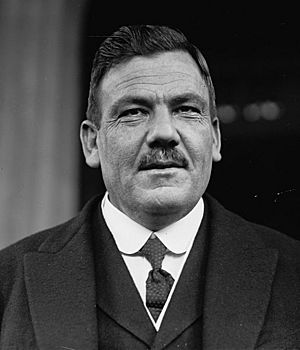
Articles 3, 5, 24, 27, and 130 in the 1917 Constitution limited the role of the Catholic Church and other religions in Mexico.
- Article 3 said that education in all schools must be completely secular (non-religious). It also stopped religious groups from helping the poor or doing scientific research.
- The Constitution also said that churches could not own property; all church property became state property.
- Article 130 said churches had no legal status. It also limited the number of ministers and said ministers not born in Mexico could not serve. Ministers were not allowed to vote or criticize the government.
Presidents Venustiano Carranza and Álvaro Obregón did not strictly enforce these rules. But in 1926, President Plutarco Elías Calles started to enforce them. This led to the Cristero War, a violent conflict. Even after the war ended in 1929, the rules stayed in the Constitution.
From 1934 to 1946, Article 3 was even stricter, requiring "socialist education." This meant education had to fight against "fanaticism and prejudices." However, this was removed in 1946. President Manuel Avila Camacho signaled the end of strict enforcement in 1940 by saying, "I am a believer."
Even when the Constitution prohibited outdoor worship, the government often looked the other way. For example, Pope John Paul II held outdoor masses during his visits in 1980 and 1990, which were technically illegal but allowed.
Changes Under President Salinas
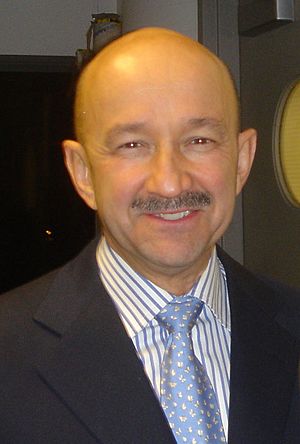
In 1988, President Carlos Salinas de Gortari announced plans to "modernize" Mexico. This included changing the relationship between the government and the Church. The Catholic Church had always wanted these rules changed.
After much debate, the Mexican legislature voted to change Articles 3, 5, 24, and 130. These changes were supported by the conservative National Action Party (PAN). The new laws allowed churches to be recognized as legal entities and gave priests more rights, though they still couldn't hold political office or own media.
The Constitution still has some limits on religious freedom. For example, outdoor worship usually needs government permission. Religious groups cannot own TV or radio stations. Ministers cannot be political candidates.
The changes to Article 27 also allowed ejido land to be sold as private property. This was part of a larger plan to change Mexico's economy. These changes were a direct cause of the Chiapas conflict, a rebellion by indigenous groups.
End of Capital Punishment
On November 8, 2005, the Senate of Mexico changed Articles 14 and 22 of the Constitution. This officially banned the death penalty in all of Mexico.
Right to Food
In 2011, Article 4 and Article 27 were updated to guarantee the right to food in Mexico. Article 4 now says: "Every person has the right to adequate food to maintain his or her wellbeing and physical, emotional and intellectual development. The State must guarantee this right." This means the government has a duty to make sure people have enough basic food.
Important Articles of the Constitution Today
Here are some of the most important articles in the Political Constitution of the United Mexican States:
Article 1
This article says that everyone in Mexico has the rights given by the Constitution. These rights cannot be taken away. Slavery is illegal in Mexico. Any enslaved person who comes to Mexico is immediately free. It also forbids all types of discrimination based on things like ethnic origin, gender, age, religion, or opinions.
Article 2
This article explains that Mexico is a unique nation. It is made up of many cultures, especially its indigenous (native) peoples. These are people who lived in Mexico before colonization and still keep their own ways of life.
Article 3
Education provided by the government should help people develop fully. It should teach love for the country and a sense of global togetherness. This education must be secular (non-religious). It should be based on science and fight against ignorance and prejudice. It must be democratic, helping people improve their lives economically, socially, and culturally. All education given by the government is free.
Article 4
All people, men and women, are equal under the law. This article also protects people's health, their right to housing, and the rights of children. Everyone has a right to a healthy environment.
Article 5
All Mexican citizens are free to choose any job or profession they want, as long as it doesn't harm others' rights.
Article 6
This article protects freedom of speech. However, there are limits. Speech cannot be morally offensive, harm others' rights, or encourage crime or public disorder.
Article 7
This article says that no law can censor the press before something is published. Freedom of the press has limits to protect private life, morality, and public peace.
Article 8
Government workers must respect people's right to make requests in writing, peacefully and respectfully. Only Mexican citizens have this right for political requests.
Article 9
Only Mexican citizens can take part in the country's political activities.
Article 10
People in Mexico can own guns in their homes for protection. But only certain types of guns approved by the Army are allowed. Federal law explains how they can be used.
Article 11
Everyone has the right to enter and leave Mexico, travel through it, and change where they live. This right can be limited by legal or administrative rules, like those for immigration or health safety.
Article 12
The Mexican government cannot create titles of nobility (like kings or queens).
Article 13
There are no private courts in Mexico. Military courts cannot judge civilians.
Article 14
Laws cannot be made to punish people for things they did before the law existed (no retroactive laws). Everyone has the right to a fair legal process. Punishments must follow written laws.
Article 15
Mexico will not send people to other countries if they are being punished for their political beliefs, or if they were enslaved. It also won't send people to countries that don't respect the civil rights given in the Mexican Constitution, like the right to life.
Article 16
If someone is caught committing a crime, anyone can arrest them and their helpers. They must then be handed over to the authorities right away.
Article 17
People cannot take justice into their own hands. All disagreements must be solved in courts. Trials should be fast, and court services are free. Imprisonment for debts is not allowed.
Article 18
Prisoners must be separated by gender. Those waiting for trial must be separate from those who have been found guilty. The government can only arrest people for crimes that allow imprisonment as a punishment.
Article 20
People who are charged with a crime have the right to remain silent.
Article 21
Police and public prosecutors are in charge of investigating crimes.
Article 23
No trial should have more than three stages. No one can be judged twice for the same crime, whether found guilty or not guilty.
Article 24
Everyone is free to choose their own religious belief and practice it, as long as it doesn't break any laws. The government cannot create or abolish any religion. Religious acts are usually done in temples.
Article 25
The government will plan and carry out the nation's development. This is to protect the country, strengthen its power, and allow people more freedom and dignity. It aims for economic growth that shares wealth fairly.
Article 26
The government will encourage democracy to help economic growth.
Article 27
All land and water in Mexico originally belong to the Nation. The Nation can allow private ownership. The government can take private property if it's for public use. The government also has the right to control how natural resources are used, making sure it benefits society and is fair. It is also responsible for protecting the environment. Foreigners cannot own land close to the borders or coasts.
Article 28
All monopolies (where one company controls everything) are forbidden. However, some areas controlled by the government, like mail, oil, and electricity, are not considered monopolies. The government will also protect important economic areas like satellite communications and railroads. Mexico has a Central Bank to keep the national currency stable. Unions and workers' groups are not considered monopolies. Copyrights and patents are also not monopolies.
Article 29
In times of invasion or serious public danger, only the President can temporarily suspend some rights. This must be done with approval from Congress.
Article 30
This article explains what makes someone a Mexican national.
Article 31
This article lists the duties of Mexicans.
Article 32
Mexicans should have priority over foreigners for government jobs and concessions, if they have equal qualifications. Foreigners, immigrants, and even naturalized citizens cannot serve as military officers or work on Mexican ships and airlines.
Article 33
The government can make any foreigner leave Mexico immediately if it believes their presence is not good for the country. Foreigners cannot participate in Mexico's political affairs.
Article 39
The power of the nation comes from the people. All government power comes from the people and is for their benefit. The people always have the right to change their form of government.
Article 34
This article is about Mexican Citizenship.
Article 55
A member of the Chamber of Deputies or a senator must be a Mexican citizen by birth.
Article 91
Members of the President's Cabinet must be Mexicans by birth.
Article 95
Supreme Court justices must be Mexican by birth.
Article 123
This article covers the rights of workers. It includes an eight-hour workday, the right to strike, a weekly day of rest, and fair payment if a worker is fired without good reason. It also says that everyone should be treated equally, no matter their race or gender. It has rules for protecting women in dangerous jobs and during pregnancy.
Article 130
This article states that the Church and the government must remain separate. It requires all churches to register with the government. It also places limits on priests and ministers, such as not being able to hold public office or campaign for political parties.
See also
In Spanish: Constitución Política de los Estados Unidos Mexicanos para niños



